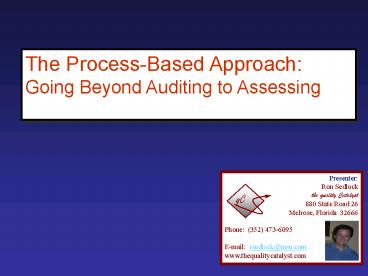Statistical Process Control SPC Class Outline - PowerPoint PPT Presentation
1 / 37
Title:
Statistical Process Control SPC Class Outline
Description:
Poke Yoke. Activity-based Costing. MBO. Concurrent Engineering. JIT. Quality Circles. MRP ... What do all of the following have in common? Answer: Cross ... – PowerPoint PPT presentation
Number of Views:106
Avg rating:3.0/5.0
Title: Statistical Process Control SPC Class Outline
1
The Process-Based Approach Going Beyond Auditing
to Assessing
Presenter Ron Sedlock the quality Catalyst 880
State Road 26 Melrose, Florida 32666 Phone
(352) 473-6095 E-mail rsedlock_at_msn.com www.the
qualitycatalyst.com
2
Select One
- Obsessed with Sex and Booze!
- Excellent Decision Maker
- Uses Systems Thinking
- Good Management Skills
3
Presentation Outline
- The Element Approach
- Process and Systems Models
- Process-Based Techniques
- In Conclusion
4
What do all of the following have in common?
Activity-based Costing MBO Concurrent
Engineering JIT Quality Circles MRP MRP II Kaizen
CIP TQM TQL Hoshin Kempner-Tregoe ZD VA/VE
- Process-Based
- Six Sigma
- DFSS
- Lean Manufacturing
- Balanced Scorecard
- SPC
- DOE
- QFD
- Benchmarking
- Reengineering
- 7 Habits
- The Learning Organization
- ISO 9001
- Baldrige
- Taguchi
- Poke Yoke
Answer Cross-Functional Teamwork
5
Quality is the resultof the system.
6
ISO 9000 Series Quality Elements (1987)
7
The Element Approach
- Not how a business really works
- Not easy for the user to interpret
- No connection to improvement
- No need for process linkages
8
Traditional Compliance Audit
9
Scope and Depth
Depth
10
Scope and Depth
Traditional Audits
Process-Based Assessments
Depth
11
Demings System Model
12
Updated System Model
Benchmarking
Management Responsibility
Resources
Design
Customer Focus
Purchasing
Product Realization
Measurement/Analysis/ Improvement
13
Model of a Process-BasedQuality Management
System (QMS)
Continual improvement of the quality management
system
Customers
Customers
Management responsibility
Resource management
Measurement, analysis and improvement
Satisfaction
Product realization
Input
Output
Requirements
Product
14
ISO90012000
- 0.2 Process approach
- The application of a system of processes within
an organization, together with the identification
and interactions of these processes, and their
management, can be referred to as the process
approach. - An advantage of the process approach is the
ongoing control that it provides over the linkage
between the individual processes within the
system of processes, as well as over their
combination and interaction.
HR
Sales
Prod
Eng
15
ISO 90012000 and Baldrige
Continual improvement of the quality management
system
1 Leadership
3 Customer and Market Focus
3 Customer and Market Focus
7 Business Results
2 Strategic Planning
- Human
- Resource
- Focus
4 Information and Analysis
Input
6 Process Management
16
(No Transcript)
17
(No Transcript)
18
Fishbone Process Model
Material
Person
Process
Machine
Method
S.I.P.O.C. Process Model
19
IPO Spider Process Model
Incoming Material
Equipment
Who
Information
Input
Output
Process
Measurement
Environment
Workplace
Decision Making
20
Model of a Process-BasedQuality Management
System (QMS)
Continual improvement of the quality management
system
Customers
Customers
Management responsibility
Resource management
Measurement, analysis and improvement
Satisfaction
Input
Product realization
Output
Requirements
Product
21
Customer Initiate Processes
O
P
I
Your Organization
22
Business Processes
23
Process Linkages
Customer Initiated Process
Customer Initiated Process
Customer Initiated Process
O
P
I
Internal Customer Initiated Process
Management Process
24
IPO Spider Web Model
Prod
25
Linkage Strength
Output
Input
26
(No Transcript)
27
(No Transcript)
28
Process-Based Audit Schedule
Ship
HR
Sales
Prod
Eng
Purch
Design
29
Auditing Systems
30
Audit the arrows
A hand-off from one operation to another? A
communication link from one department or company
to another? Transporting product from one
location to another? An input to the
process? Indicating off-line processes?
31
Audit the diamonds
Was the decision based on facts? Who made the
decision? How timely? How many yess vs.
nos? Where are they located?
32
Audit Report Content
33
Why Process-Based?
- To provide input for management review.
- To assess the system effectiveness.
- To provide insight to process owners.
34
Optimizing the System
Cross-Functional Improvement
Functional Control
35
In conclusion
- Audit linkages.
- Report the good.
- Add value to process owners.
- Add value to management review.
- Bottom line Go from auditing to assessing
36
au?di?tor (ô'di-ter) n. 1. One who hears a
listener.
37
Thanks for listening!The End































